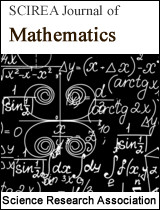AN OVERVIEW ON INTEGERS OF THE FORM \mathbf{6}^\mathbit{n}\ +\ \mathbf{1}
DOI: 10.54647/mathematics110403 107 Downloads 160848 Views
Author(s)
Abstract
We pose various congruences on the integers of form 6^n\ +\ 1, n\ \in\ Z_+, which may encourage younger number theorists to do research in number theory and settle new dimensions in this field. We saw that there are only three prime numbers, namely 7,\ 37, and 1297 of form 6^n\ +\ 1, whenever n\ \in\ Z_+-{{2}^km,\ k\geq6,\ m\equiv1(mod\ 2)}, and no one Fermat numbers represent in this form. Moreover, these integers end with seven, like Fermat numbers F_n,\ n\ \geq\ 2. Also, we discussed some congruences with number theoretic functions \sigma,\varphi, and Möbious function \mu, and generates various families of integers with \mu(n)=0.
Keywords
Congruences, Fermat Number, Number Theoretic Functions, Prime Number
Cite this paper
RAJIV KUMAR, SATISH KUMAR, MUKESH KUMAR, DUSHIYANT KUMAR,
AN OVERVIEW ON INTEGERS OF THE FORM \mathbf{6}^\mathbit{n}\ +\ \mathbf{1}
, SCIREA Journal of Mathematics.
Volume 8, Issue 3, June 2023 | PP. 97-106.
10.54647/mathematics110403
References
| [ 1 ] | Balog, A., Cojocaru, A. C., & David, C. (2011). Average twin prime conjecture for elliptic curves. American journal of mathematics, 133(5), 1179-1229. |
| [ 2 ] | Brillhart, J. & et al., (1988). Factorization of ± 1, b=2, 3, 5, 6, 7, 10, 11, 12 up to high powers. Amer. Math. Soc., Providence. MR 90d:11009. |
| [ 3 ] | Burton, D. M., (2012). Elementary Number Theory. New York McGraw Hill. |
| [ 4 ] | Crandall, R. E., & Pomerance, C. (2005). Prime numbers: a computational perspective (Vol. 2). New York: Springer. |
| [ 5 ] | Deza, E. (2021). Mersenne Numbers and Fermat Numbers (Vol. 1). World Scientific. |
| [ 6 ] | Gunasekara, A. D. V., Jayathilake, A. A. C. A., & Perera, A. A. I. (2015). Survey on prime numbers. Elixir Appl. Math, 88, 36296-36301. |
| [ 7 ] | Krizek, M., Luca, F., & Somer, L. (2002). 17 Lectures on Fermat Numbers: From Number Theory to Geometry - Anna’s .... Springer Science & Business Media. |
| [ 8 ] | Kumar, R., & Kumar, S. (20170. Note on a Family of Integers of the form. Global Journal of Mathematical Sciences: Theory and Practical, 9(2), 127-131. http://www.irphouse.com |
| [ 9 ] | Leach, R., Mareschal, D., & Cooper, R. P. (2008). “Analogy as relational priming: a developmental and computational ...” Behavioral and Brain Sciences, 31(4), 357-378. |
| [ 10 ] | Nathanson, M. B. (1996). Additive Number Theory the Classical Bases (Vol. 164). Springer Science & Business Media. |
| [ 11 ] | Nazardonyavi, S. (2012). Some history about twin prime conjectures. arXiv preprint arXiv:1205.0774. |
| [ 12 ] | Robinson, R. M. (1954). Mersenne and Fermat numbers. Proceedings of the American Mathematical Society, 5(5), 842-846. |
| [ 13 ] | Shankar, B. R. (2022). Additive number theory: Notes and some problems. 3c Empresa: investigación y pensamiento crítico, 11(2), 186-196. |
| [ 14 ] | Tsang, C., Theorey, M. N., & Stein, W. (2010). Fermat numbers. University of Washington, dapat diunduh di https://wstein. org/edu/2010/414/projects/tsang. pdf. |
| [ 15 ] | Wu, J. (2007). “[0705.1652] Chen's double sieve, Goldbach's conjecture and the twin ....” arXiv preprint arXiv:0705.1652. |
| [ 16 ] | Buya, S. B. Proof of the twin Prime Conjecture. Research gate. |

